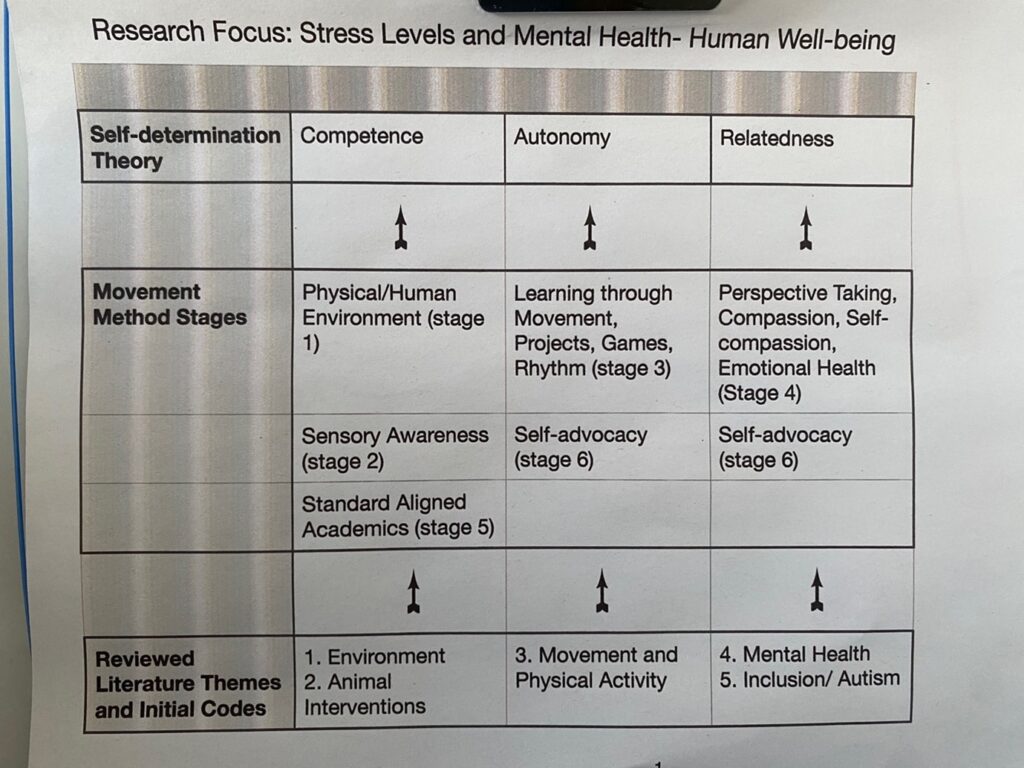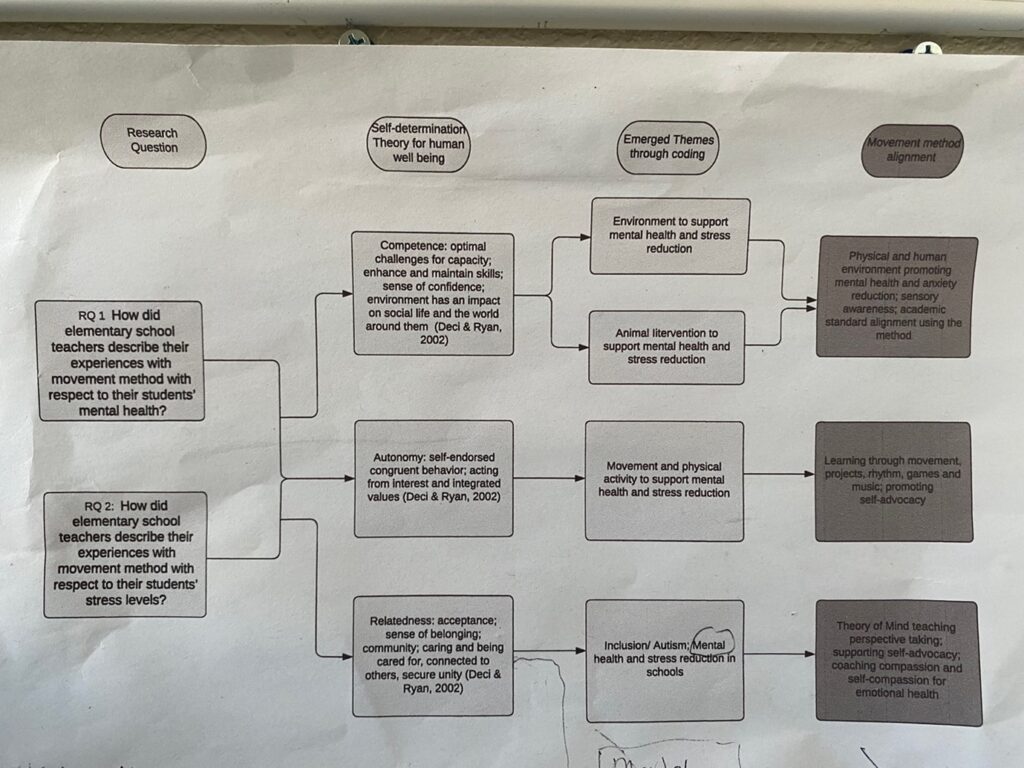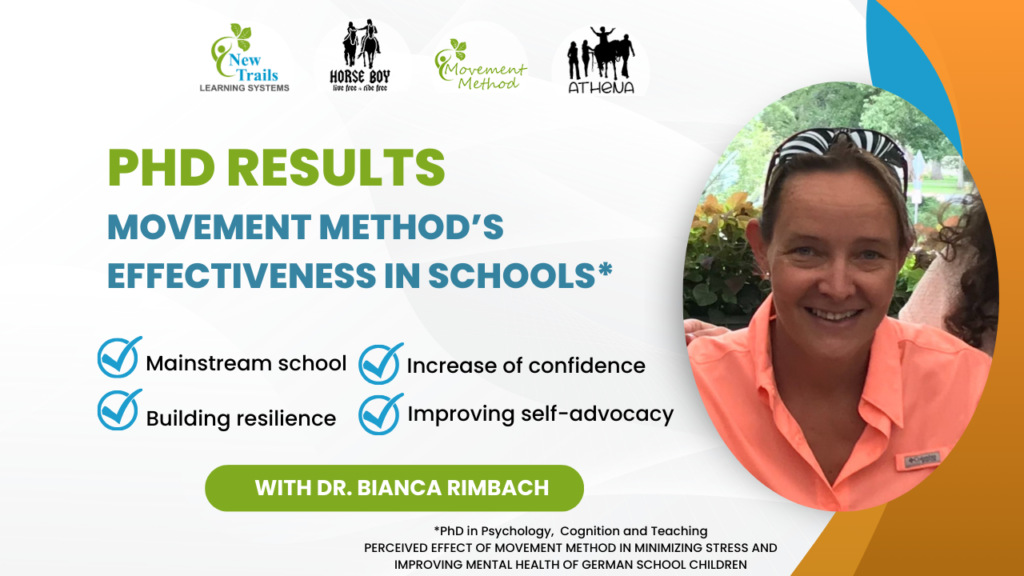Grand Canyon University By Bianca Rimbach
Successfully Defended and Approved by All Dissertation Committee Members November 20, 2023
Abstract
The purpose of this qualitative descriptive study was to explore how elementary school teachers in Nordrhein Westfalen, Germany described their experience with movement method with respect to students’ mental health and stress levels. The theoretical framework was Ryan and Deci’s (2000) self-determination theory. The two research questions were: How did elementary school teachers describe their experience with movement method with respect to their student’s mental health, and how did elementary school teachers describe their experience with movement method with respect to their student’s stress level? The sample included 20 teachers, 13 of whom participated in the interview and focus group, and were trained in movement method 1 and 2, implemented at least one of the six stages at an elementary school in Germany. Braun and Clarke’s (2021) six step reflective thematic analysis was used to identify five themes: Animal interventions (26 codes), inclusion and autism (61 codes), movement and physical activity (218 codes), mental health (337 codes) and environment (351 codes). Participants reported that movement method was useful for stress reduction, for inclusion, and students’ mental health. These findings from the study should lead to the implementation of movement method as an effective, innovative strategy to improve student stress reduction and mental health. More research is needed on the impact of the individual stages of movement method stages on student well-being as well as the impact on teacher well-being and reduction of burn out.
Keywords: Mental health, stress reduction, movement method, innovative teaching, best practice
Video of Dr. Bianca Rimbach explaining the results
Interview Participant Demographics
| Pseudonym | Age (M = 49.2) | Years of Experience in the Classroom (M = 17.25) | Number of Students in Class (M = 21) |
| Maeve | 58 | 32 | 25 |
| Ezra | 54 | 20 | 10-30 |
| Luna | 56 | 29 | 20 |
| Eloise | 39 | 9 | 25 |
| Ophelia | 28 | 2 | 25 |
| Isla | 50 | 13 | 23 |
| Aurelia | 41 | 13 | 28 |
| Alice | 49 | 17 | 28 |
| Aurora | 53 | 5 | 12 |
| Sadie | 60 | 28 | 22 |
| Charlotte | 56 | 28 | 30 |
| Ava | 46 | 11 | 24 |
| Note. Pseudonyms were chosen from the website https://nameberry.com/popular names | |||
Interview Data
| Variable | Interview Date | Duration | Number of Transcript Pages (Times New Roman, single-spaced, 12-point font) |
| Maeve | 05 May, 2022 | 52 minutes | 20 |
| Ezra | 04 May, 2022 | 50 minutes | 20 |
| Luna | 03 May, 2022 | 53 minutes | 24 |
| Charlotte | 02 May, 2022 | 59 minutes | 17 |
| Ophelia | 15 April, 2022 | 57 minutes | 21 |
| Ava | 14 April, 2022 | 52 minutes | 14 |
| Aurelia | 13 April, 2022 | 43 minutes | 16 |
| Alice | 12 April, 2022 | 61 minutes | 29 |
| Aurora | 11 April, 2022 | 66 minutes | 24 |
| Sadie | 08 April, 2022 | 49 minutes | 18 |
| Mean | N/A | 54.2 minutes | 20.3 |
| Total | N/A | 542 minutes | 203 |
Focus Group Data
| Pseudonym | Participation Length | Contributions | Initial Codes Produced |
| Alice | 59 minutes | 16 | 19 |
| Isla | 59 minutes | 6 | 25 |
| Aurelia | 59 minutes | 11 | 20 |
| Eloise | 59 minutes | 6 | 20 |
| Ophelia | 59 minutes | 13 | 15 |
| Mean Total | 59 minutes 59 minutes | 10.4 52 | 19.8 99 |
| Code Appearances in Data |

Six Step Data Analysis Process
Note. Adapted from Braun and Clarke (2021), Six phases of thematic analysis.

Note. Adapted from “Horse Boy Method 1: Train the Trainer Handbook,” by Isaacson, R., 2019.

Flow chart to explain alignment with theoretical framework, recent scientific references and movement method:


Key References:
- Abdullah, M., Anira, W., & Ghani, I. (2017). Exploring the elements of natural landscape character in engaging children with their natural environment. Environment-Behaviour Proceedings Journal, 2, 209. 10.21834/e-bpj.v2i5.695.
- American Psychological Association. (2020). Stress in the Time of COVID-19. Stress in America 2020. Retrieved May 25, 2020 from https://www.apa.org/news/press/releases/stress/2020/report
- Augello, R., Sciara, S., & Arcuri, L. (2019). Environmental psychology and ecopsychology in evolutionary age: cognitive, affective and relational aspects. INFAD, 2(2), 147–154. https://doi-org.lopes.idm.oclc.org/10.17060/ijodaep.2019.n2.v2.1750
- Barrable, A., & Arvanitis, A. (2019). Flourishing in the forest: looking at Forest School through a self-determination theory lens. Journal of Outdoor & Environmental Education, 22(1), 39–55. https://doi-org.lopes.idm.oclc.org/10.1007/s42322-018-0018-5
- Bavel, J. V., Baicker, K., & Boggio, P. S. (2020). Using social and behavioral science to support COVID-19 pandemic response. Nat Hum Behav. https://doi.org/10.1038/s41562-020-0884-z
- Becker, C., Schmidt, S., Neuberger, E. W. I., Kirsch, P., Simon, P., & Dettweiler, U. (2019). Children’s cortisol and cell-free DNA trajectories in relation to sedentary behavior and physical activity in school: A pilot study. Frontiers in Public Health, 7. https://doi-org.lopes.idm.oclc.org/10.3389/fpubh.2019.00026
- Bourrier, S., Berman, M., & Enns, J. (2018). Cognitive Strategies and Natural Environments Interact in Influencing Executive Function. Frontiers in Psychology. https://doi-org.lopes.idm.oclc.org/10.3389/fpsyg.2018.01248
- Braun, V., & Clarke, V. (2021). One size fits all? What counts as quality practice in (reflexive) thematic analysis?. Qualitative research in psychology, 18(3), 328-352. https://doi.org/10.1080/14780887.2020.1769238
- Clemente-Suarez, J., & Ruisoto-Palomera, P. (2020). Effects of the psychophysiological stress response in human behavior. Physiology & Behavior, 214. https://doi-org.lopes.idm.oclc.org/10.1016/j.physbeh.2019.112761
- Dinoff, A., Herrmann, N., Swardfager, W., & Lanctôt, K. L. (2017). The effect of acute exercise on blood concentrations of brain-derived neurotrophic factor in healthy adults: a meta-analysis. The European Journal of Neuroscience, 46(1), 1635–1646. https://doi.org/10.1111/ejn.13603
- Dreyer, B. P. (2023). Stepping Up to the Plate—The Role of Pediatricians in Addressing the Child and Adolescent Mental Health Crisis. JAMA Network Open, 6(1), e2249578. 10.1001/jamanetworkopen.2022.49578
- Ebersoehn, L. (2020). Collective resilience to global challenge: a collective wellbeing agenda to transform towards sustained equitable education. Práxis Educativa, 15, 1–14. https://doi-org.lopes.idm.oclc.org/10.5212/PraxEduc.v.16344.082
- Eschrich, L. (2020). Lernen in Bewegung-Frageborgenevaluation in einer Grundschule.
- Escher, J. (2020, June 16). A Primer on the Abnormal Neurobiology of Autism – NCSA. National Council on Severe Autism. https://www.ncsautism.org/blog//abnormal-neurobiology.
- Faegerstam, E., & Grotherus, A. (2018). Secondary school students’ experience of outdoor learning: A Swedish case study. Education, 138(4), 378-392. https://eric.ed.gov/?id=EJ1180295
- Fredericks, C. R., Kokot, S. J., & Krog, S. (2006). Using a developmental movement programme to enhance academic skills in grade 1 learners. / Die gebruik van ’n bewegingsontwikkelingsprogram om akademiese prestasies by graad 1 leerders te bevorder. South African Journal for Research in Sport, Physical Education & Recreation, 28(1), 29–42. https://doi.org/10.4314/sajrs.v28i1.25929
- Gee, N. R., Griffin, J. A., & McCardle, P. (2017). Human-animal interaction research in school settings: Current knowledge and future directions. AERA Open, 3(3). https://doi.org/10.1177%2F2332858417724346
- Goldberg, J. (2020). Children of the pandemic: How will kids be shaped by the coronavirus crisis? Science. https://www.sciencemag.org/news/2020/04/children-pandemic-how-will-kids-be-shaped-coronavirus-crisis.
- Golub, Y., Kuitunen-Paul, S., Panaseth, K., Stonawski, V., Frey, S., Steigleder, R., Grimm, J., Goecke, T. W., Fasching, P. A., Beckmann, M. W., Kornhuber, J., Kratz, O., Heinrich, H., Moll, G. H., & Eichler, A. (2019). Salivary and hair cortisol as biomarkers of emotional and behavioral symptoms in 6-9 year old children. Physiology & Behavior, 209. https://doi-org.lopes.idm.oclc.org/10.1016/j.physbeh.2019.112584
- Harris, F. (2018). Outdoor learning spaces: The case of forest school. Area, 50(2), 222–231. https://rgs-ibg.onlinelibrary.wiley.com/doi/pdf/10.1111/area.12360
- Isaacson, R. (2016). The long ride home. Elgin, TX: Horse Boy Press.
- Kubzansky, L. D., Huffman, J. C., Boehm, J. K., Hernandez, R., Kim, E. S., Koga, H. K., & Labarthe, D. R. (2018). Positive psychological well-being and cardiovascular disease: JACC health promotion series. Journal of the American College of Cardiology, 72(12), 1382-1396. https://pubmed.ncbi.nlm.nih.gov/30213332/
- Machova, K., Prochazkova, R., Vadronova, M., Souckova, M., & Prouzova, E. (2020). Effect of dog presence on stress levels in students under psychological strain: A pilot study. International Journal Of Environmental Research And Public Health, 17(7). https://doi-org.lopes.idm.oclc.org/10.3390/ijerph17072286
- Maenner, M. J., Warren, Z., & Williams, A. R., (2023). Prevalence and Characteristics of Autism Spectrum Disorder Among Children Aged 8 Years- Autism and Developmental Disabilities Monitoring Network, 11 Sites, United States, 2020. MMWR Surveill Summ 2023; 72 (No. SS-2): 1-14 DOI: http://dx.doi.org/10.15585/mmwr.ss7202a1.
![]()
